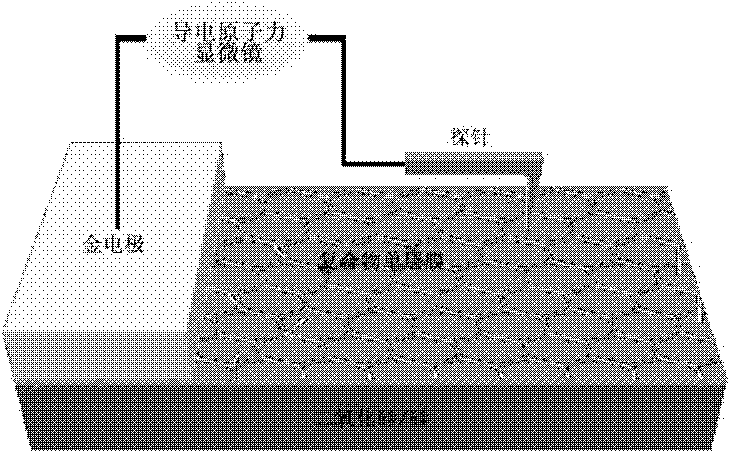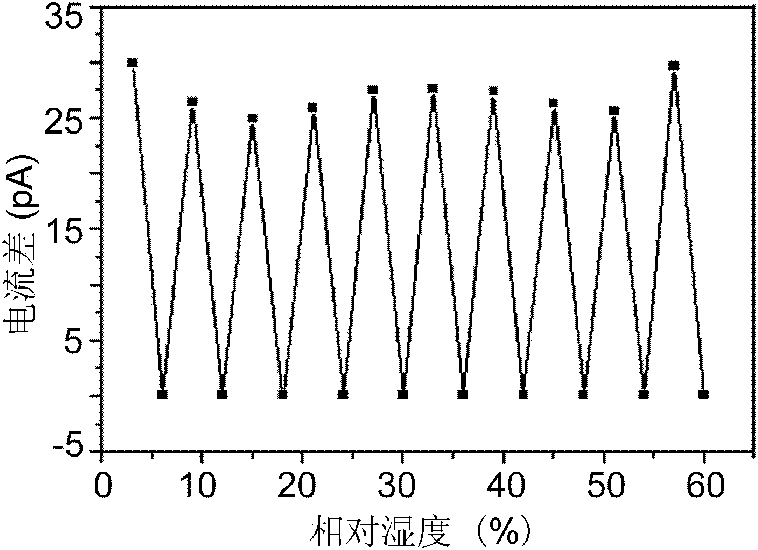Preparation method of graphene complex based humidity sensor
A humidity sensor and composite technology, applied in the field of nanomaterials, can solve the problem that the graphene humidity sensor has not been reported, and achieve the effect of a simple method
- Summary
- Abstract
- Description
- Claims
- Application Information
AI Technical Summary
Problems solved by technology
Method used
Image
Examples
Embodiment 1
[0020] 1. Dilute the concentration of polyvinylpyrrolidone-graphene composite aqueous solution made in the laboratory to 0.02mg / ml, and spread the composite on the surface of silicon oxide / silicon base in the form of a single-layer film by spin coating.
[0021] 2. A gold electrode with a thickness of 80nm is plated on the half surface of the monolayer film.
[0022] 3. Imaging in CAFM mode and determining the position of the measured sample.
[0023] 4. Adjust the relative humidity of the surrounding environment to 30%, 40%, 50%, 60%, 70%, 80%, and 90%, respectively, apply a bias voltage of 8V to the tested point through the probe, and perform I-V under different humidity curve measurement.
[0024] Such as figure 1 As shown, it is a schematic diagram of the sensor prepared in this embodiment, wherein: a gold electrode and a polyvinylpyrrolidone-graphene conductive film are used as two electrodes respectively, and after imaging based on the contact mode of the atomic force ...
Embodiment 2
[0028] 1. Dilute the concentration of polyvinylpyrrolidone-graphene composite aqueous solution made in the laboratory to 0.01mg / ml, and spread the composite on the surface of silicon oxide / silicon base in the form of a single-layer film by spin coating.
[0029] 2. Plating a layer of silver electrode with a thickness of 50nm on the half surface of the monolayer film.
[0030] 3. Imaging in CAFM mode and determining the position of the measured sample.
[0031] 4. Adjust the relative humidity of the surrounding environment to 30%, 40%, 50%, 60%, 70%, 80%, and 90%, apply a bias voltage of 1V to the tested point through the probe, and perform I-V curves under different humidity Measurement.
Embodiment 3
[0033] 1. Dilute the concentration of polyvinylpyrrolidone-graphene composite aqueous solution made in the laboratory to 0.05mg / ml, and spread the composite on the surface of silicon oxide / silicon base in the form of a single-layer film by spin coating.
[0034] 2. Plating a layer of silver electrode with a thickness of 100nm on the half surface of the monolayer film.
[0035] 3. Imaging in CAFM mode and determining the position of the measured sample.
[0036] 4. Adjust the relative humidity of the surrounding environment to 30%, 40%, 50%, 60%, 70%, 80%, and 90%, apply a bias voltage of 1V to the tested point through the probe, and perform I-V curves under different humidity Measurement.
[0037] During the preparation of the humidity sensor, the optimum concentration of the compound was determined to be 0.02 mg / ml by adjusting the concentration of the polyvinylpyrrolidone-graphene compound; in addition, by selecting different electrodes and their thicknesses, the best elect...
PUM
| Property | Measurement | Unit |
|---|---|---|
| thickness | aaaaa | aaaaa |
| thickness | aaaaa | aaaaa |
| thickness | aaaaa | aaaaa |
Abstract
Description
Claims
Application Information
 Login to View More
Login to View More - R&D
- Intellectual Property
- Life Sciences
- Materials
- Tech Scout
- Unparalleled Data Quality
- Higher Quality Content
- 60% Fewer Hallucinations
Browse by: Latest US Patents, China's latest patents, Technical Efficacy Thesaurus, Application Domain, Technology Topic, Popular Technical Reports.
© 2025 PatSnap. All rights reserved.Legal|Privacy policy|Modern Slavery Act Transparency Statement|Sitemap|About US| Contact US: help@patsnap.com



